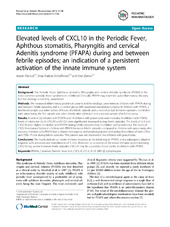Elevated levels of CXCL10 in the Periodic Fever, Aphthous stomatitis, Pharyngitis and cervical Adenitis syndrome (PFAPA) during and between febrile episodes; an indication of a persistent activation of the innate immune system
Peer reviewed, Journal article
Published version
Permanent lenke
https://hdl.handle.net/1956/7848Utgivelsesdato
2013-10-17Metadata
Vis full innførselSamlinger
Originalversjon
https://doi.org/10.1186/1546-0096-11-38Sammendrag
Background: The Periodic Fever, Aphthous stomatitis, Pharyngitis and cervical Adenitis syndrome (PFAPA) is the most common periodic fever syndrome in childhood. Clinically, PFAPA may resemble autoinflammatory diseases, but the etiology is not fully understood. Methods: We measured inflammatory proteins in plasma and hematologic parameters in children with PFAPA during and between febrile episodes, and in a control group with suspected bacterial pneumonia. In children with PFAPA, a first blood sample was taken within 24 hours of a febrile episode and a second sample between episodes. In children with pneumonia, the first sample was taken shortly after admission and a second sample after full recovery. Results: A total of 22 children with PFAPA and 14 children with pneumonia were included. In children with PFAPA, levels of interleukin (IL) 6, CXCL10 and CCL4 were significantly increased during febrile episodes. The levels of IL-6 and CXCL10 were higher in children with PFAPA during febrile episodes than in children with pneumonia. The levels of CXCL10 remained higher in children with PFAPA between febrile episodes compared to children with pneumonia after recovery. Children with PFAPA had a relative eosinopenia and lymphocytopenia with reduced numbers of both CD4+ and CD8+ T cells during febrile episodes. This pattern was not observed in the children with pneumonia. Conclusions: The results indicate an innate immune response as the initial step in PFAPA, and a subsequent adaptive response with activation and redistribution of T cells. Moreover, an activation of the innate immune system involving CXCL10 may persist between febrile episodes. CXCL10 may be a possibly clinical marker in children with PFAPA.
Utgiver
BioMed CentralTidsskrift
Pediatric RheumatologyOpphavsrett
Copyright 2013 Førsvoll et al.; licensee BioMed Central Ltd.Jostein Førsvoll et al.; licensee BioMed Central Ltd.

